Physical Address
304 North Cardinal St.
Dorchester Center, MA 02124
Physical Address
304 North Cardinal St.
Dorchester Center, MA 02124
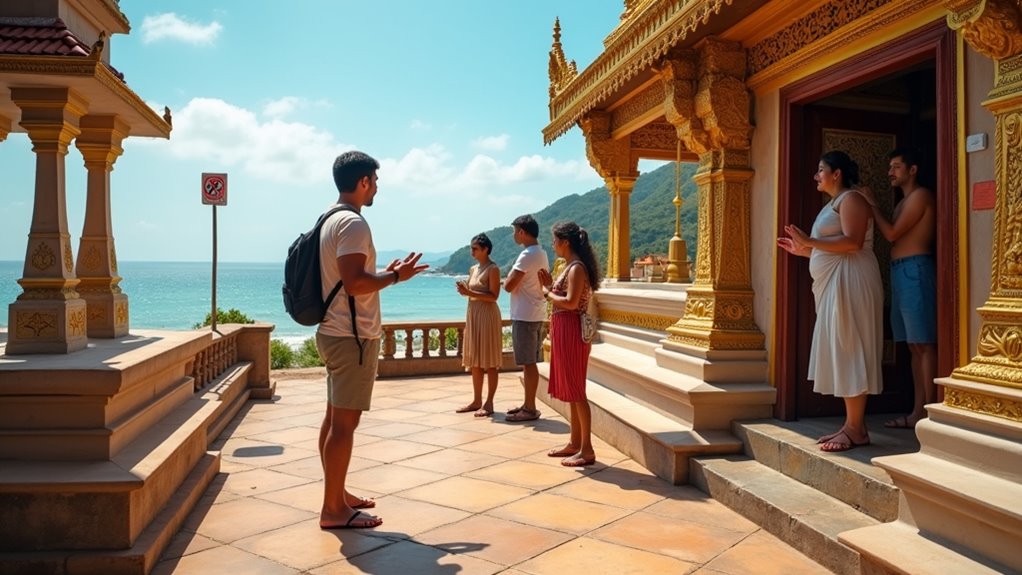
Discover essential Sri Lankan etiquette, from temple dress codes to wildlife ethics, that will transform your first visit.
In Sri Lanka, make certain you have an ETA visa, dress modestly at temples, and remove shoes when entering religious sites. Use your right hand for eating and transactions, bargain respectfully at markets, and carry cash in rural areas. Opt for ethical wildlife tours, book train tickets early, and greet locals with “Ayubowan.” Stay hydrated with sealed bottled water and pack layers for weather variations. Our detailed guide covers everything you’ll need for a culturally respectful visit.
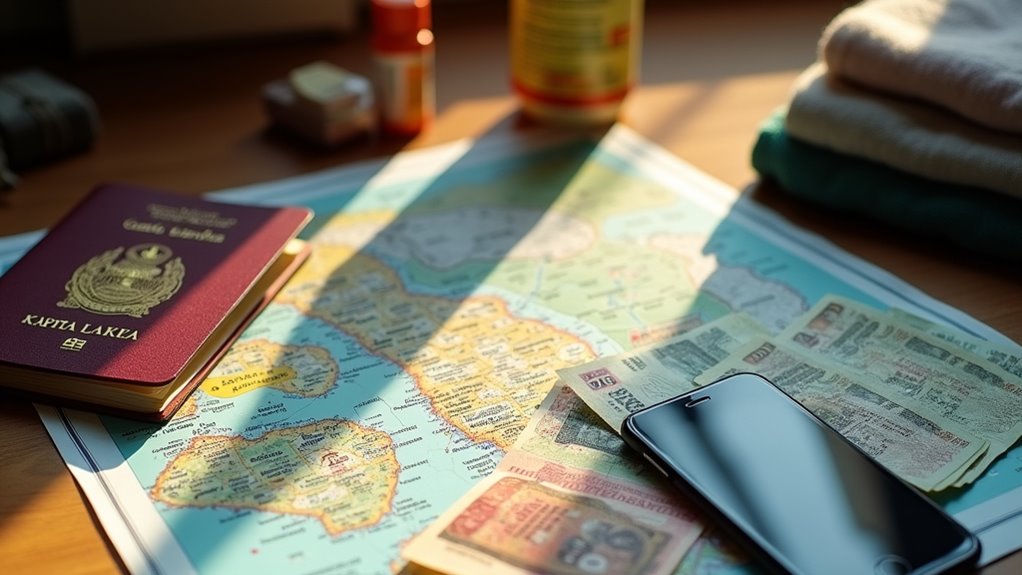
Before you commence your Sri Lankan adventure, securing the proper travel documentation is essential. Your passport must be valid for at least six months beyond your entry date, with at least one blank page for stamps.
Proper documentation is your passport to paradise—ensure validity extends six months beyond your arrival.
Apply online for an Electronic Travel Authorization (ETA), which costs $20 for SAARC countries and $50 for others.
For your ETA application, prepare two recent photos, proof of return tickets, and accommodation details. Once approved, print your ETA to present at immigration.
While processing is typically quick, allow extra time before your departure date.
For longer stays, you’ll need to submit a bank statement proving adequate funds.
U.S. nationals can apply for a special 5-year multiple entry visa under the Reciprocal Visa Scheme.
Though not mandatory, travel insurance is recommended for unexpected issues.
Check weather forecasts and local safety guidelines before packing your bags.
Preparing for potential health challenges should be a priority when visiting Sri Lanka, as the country’s tropical climate presents unique medical considerations.
While yellow fever vaccination isn’t required for most travelers, hepatitis A and B vaccines are strongly recommended due to contamination risks.
Dengue fever poses a significant threat, so pack insect repellent and wear protective clothing.
You’ll find adequate medical facilities in major cities, but services become limited in rural areas.
Always carry a first aid kit with essentials like pain relievers and band-aids.
Purchase extensive travel insurance before your trip, as medical expenses can add up quickly.
Maintain good personal hygiene and be cautious about food and water sources to prevent gastrointestinal issues.
Stay hydrated and use sun protection to avoid heat-related illnesses during your travels.
Women travelers should consider delaying pregnancy attempts for two months after returning from Sri Lanka due to Zika virus concerns.

Sri Lanka’s diverse regional climates mean timing your visit can substantially impact your experience. The west and south coasts shine from December to April, offering ideal beach conditions during this summer period. However, if you’re heading east, plan for September to November when it’s dry and perfect for surfing.
Hill Country remains cool year-round (averaging 19°C), with April being suitable for trekking and climbing Sigiriya. Pack layers for chilly nights regardless of when you visit. Travelers should note that humidity levels in this region typically maintain 70-80% year-round.
For a detailed cultural experience, aim for the shoulder seasons of April or September-October. You’ll enjoy lower prices, fewer crowds, and special events like Avurudu (New Year) celebrations in April or the elephant gathering at Minneriya National Park in August-September.
Beyond timing your trip perfectly, understanding temple etiquette forms a cornerstone of respectful travel in Sri Lanka. When visiting temples, dress modestly by covering shoulders and knees, and always remove shoes and headwear before entering sacred spaces.
Maintain a quiet demeanor inside temples, switch phones to silent, and avoid photographing Buddha statues directly. Use your right hand for offerings, eating, and interactions. Always be mindful to avoid turning your back towards Buddha statues or stupas as a sign of reverence.
Respect the serenity of sacred spaces by speaking softly and using only your right hand for offerings.
Some Hindu temples restrict inner shrine access for non-Hindus, and men may need to remove shirts at certain sites. Women should be aware that access to some areas might be limited.
Consider bringing socks for hot stone floors and making small donations to support temple maintenance. For deeper cultural understanding, respectful observation and hiring local guides are invaluable practices.
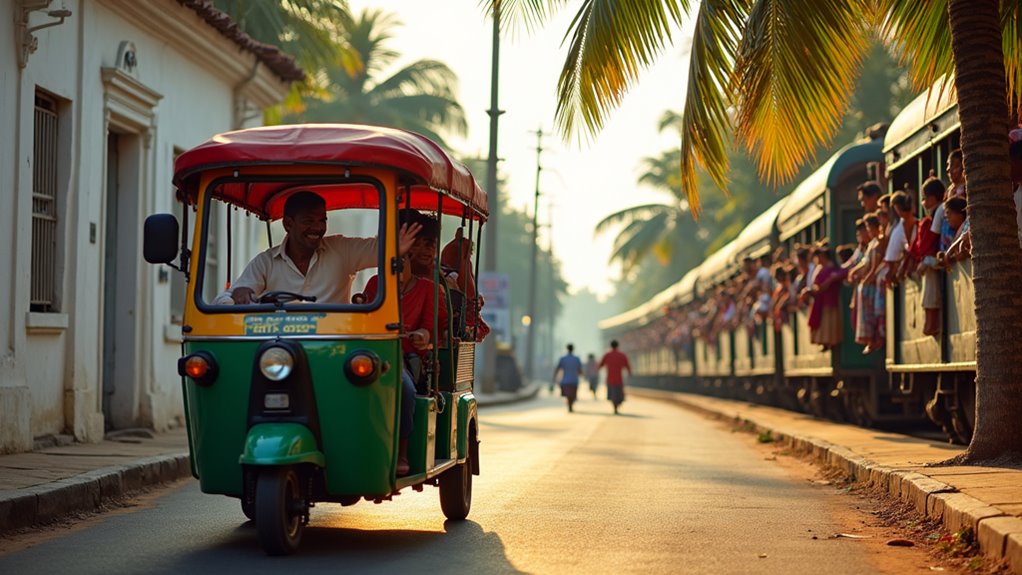
When planning your Sri Lankan adventure, traveling the country’s diverse transportation options can greatly enhance your experience. Negotiate tuk-tuk fares before starting your journey and use apps like PickMe in major cities for reliable pricing. Avoid tuk-tuks during heavy rain or at night in unfamiliar areas.
For longer journeys, trains offer spectacular views along routes like Colombo to Kandy and Ella to Nuwara Eliya. Book first-class tickets in advance during peak seasons for comfort and guaranteed seats. Morning trains provide the best scenery and cooler conditions. Reserved seats can be booked up to 30 days in advance at stations or by phone, but they sell out quickly so early booking is essential.
Buses reach even remote areas and are incredibly cost-effective. Keep small change handy and consider air-conditioned options for longer routes. Travel off-peak when possible to avoid overcrowding, and always keep valuables secure while using public transportation.
Managing food safety in Sri Lanka requires attention to detail while still enjoying the island’s incredible culinary offerings. Prioritize establishments that maintain clean preparation areas and proper facilities. The busier the venue, the fresher the food likely is. Dishes like aappa (hoppers) and fried rice that are cooked to order tend to be safer options at roadside eateries.
Food safety in Sri Lanka balances caution with culinary adventure. Seek clean kitchens and popular spots for the freshest experiences.
Sri Lanka’s food safety standards are improving through initiatives with organizations like UNIDO.
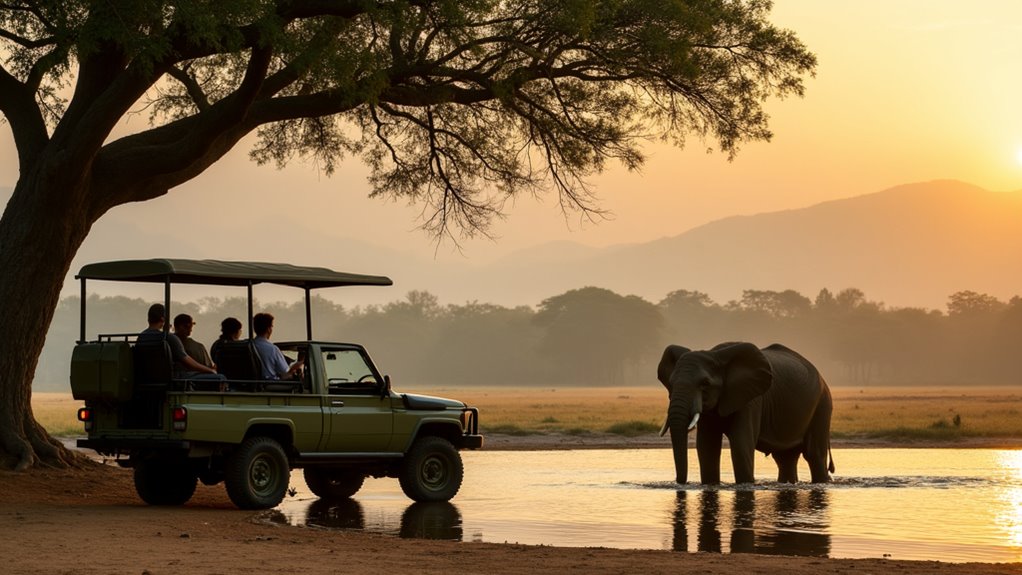
Sri Lanka’s magnificent wildlife offers travelers unforgettable encounters with elephants, leopards, and hundreds of bird species in their natural habitats. When planning your safari, aim for the dry season (June-August) and book well in advance.
Always maintain a respectful distance from animals, remain quiet, and stay in your vehicle. Never feed wildlife or use flash photography, as these disrupt natural behaviors. Choose operators who support conservation efforts and follow your guide’s instructions—they’re essential for spotting elusive creatures like leopards.
Pack binoculars, appropriate clothing, and sun protection. The Minneriya and Kadulla Parks offer an extraordinary opportunity to witness the Elephant Gathering, where the highest concentration of elephants on earth congregates during the dry season.
After your safari, consider supporting local communities by purchasing local products and sharing your experiences responsibly. Remember that your actions directly impact these precious ecosystems and the wildlife that depends on them.
Three aspects of financial etiquette deserve special attention in Sri Lanka: bargaining, tipping, and handling money. Understanding these practices helps you navigate transactions respectfully while avoiding overpaying.
The Sri Lankan Rupee (LKR) is non-convertible, so exchange currency at airports, banks, or official exchange offices for the best rates. Be aware that many cultural attractions have dual pricing systems with significantly higher admission fees for foreigners than locals.
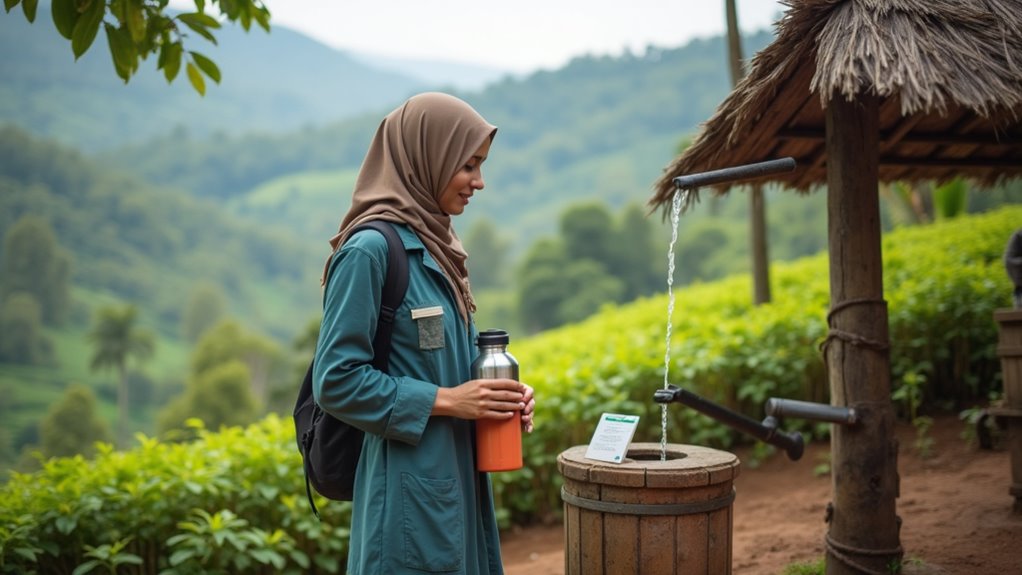
While planning your Sri Lankan adventure, it’s crucial to take into account how your trip impacts local communities and environments. Look for accommodations with eco-certifications like the Good Travel Seal, such as Aviyana Private Chalets or Aarunya Nature Resort, which implement solar power and water conservation.
Rent tuk-tuks through local startups that benefit community owners, and hire resident guides to keep tourism income within the area. Participate in community-based workshops and respect wildlife by choosing ethical tours with strict animal protection guidelines. The growing interest in eco-friendly experiences is reshaping how visitors engage with Sri Lanka’s natural wonders.
Avoid single-use plastics, which are banned in many tourist zones. Consider joining conservation efforts like tree planting or marine protection activities.
With Sri Lanka targeting 2.5 million visitors by 2025, your sustainable choices contribute to preserving this beautiful destination for future travelers.
Understanding local customs transforms your Sri Lankan experience from mere sightseeing to meaningful culture. Sri Lankans value politeness and respect, especially toward elders and in religious settings.
Remember that public displays of affection are frowned upon, particularly in rural areas. Women should avoid sitting next to Buddhist monks, and everyone should speak softly as loud behavior may be seen as disrespectful. Avoid touching anyone’s head, especially children, as this area is considered spiritually sensitive in Sri Lankan culture.
You’ll absolutely fall in love with Sri Lanka’s incredible diversity! Remember, following these dos and don’ts isn’t just helpful—it’s the difference between a good trip and the journey of a lifetime. Pack your respect alongside your sunscreen, embrace the local pace, and you’ll discover a thousand tiny treasures that rushed travelers miss completely. Your first Sri Lankan adventure definitely won’t be your last.